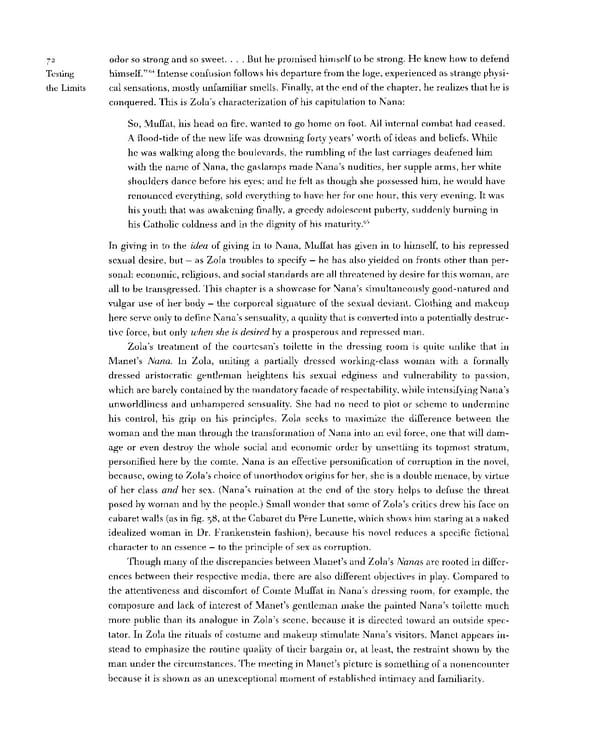72 odor so strong and so sweet. . . . But he promised himself to be strong. He knew how to defend 64 Testing himself." Intense confusion follows his departure from the loge, experienced as strange physi- the Limits cal sensations, mostly unfamiliar smells. Finally, at the end of the chapter, he realizes that he is conquered. This is Zola's characterization of his capitulation to Nana: So, Muffat, his head on fire, wanted to go home on foot. All internal combat had ceased. A flood-tide of the new life was drowning forty years' worth of ideas and beliefs. While he was walking along the boulevards, the rumbling of the last carriages deafened him with the name of Nana, the gaslamps made Nana's nudities, her supple arms, her white shoulders dance before his eyes; and he felt as though she possessed him, he would have renounced everything, sold everything to have her for one hour, this very evening. It was his youth that was awakening finally, a greedy adolescent puberty, suddenly burning in his Catholic coldness and in the dignity of his maturity.65 In giving in to the idea of giving in to Nana, Muffat has given in to himself, to his repressed sexual desire, but — as Zola troubles to specify — he has also yielded on fronts other than per- sonal: economic, religious, and social standards are all threatened by desire for this woman, are all to be transgressed. This chapter is a showcase for Nana's simultaneously good-natured and vulgar use of her body — the corporeal signature of the sexual deviant. Clothing and makeup here serve only to define Nana's sensuality, a quality that is converted into a potentially destruc- tive force, but only when she is desired by a prosperous and repressed man. Zola's treatment of the courtesan's toilette in the dressing room is quite unlike that in Manet's Nana. In Zola, uniting a partially dressed working-class woman with a formally dressed aristocratic gentleman heightens his sexual edginess and vulnerability to passion, which are barely contained by the mandatory facade of respectability, while intensifying Nana's unworldliness and unhampered sensuality. She had no need to plot or scheme to undermine his control, his grip on his principles. Zola seeks to maximize the difference between the woman and the man through the transformation of Nana into an evil force, one that will dam- age or even destroy the whole social and economic order by unsettling its topmost stratum, personified here by the comte. Nana is an effective personification of corruption in the novel, because, owing to Zola's choice of unorthodox origins for her, she is a double menace, by virtue of her class and her sex. (Nana's ruination at the end of the story helps to defuse the threat posed by woman and by the people.) Small wonder that some of Zola's critics drew his face on cabaret walls (as in fig. 38, at the Cabaret du Pere Lunette, which shows him staring at a naked idealized woman in Dr. Frankenstein fashion), because his novel reduces a specific fictional character to an essence — to the principle of sex as corruption. Though many of the discrepancies between Manet's and Zola's Nanas are rooted in differ- ences between their respective media, there are also different objectives in play. Compared to the attentiveness and discomfort of Comte Muffat in Nana's dressing room, for example, the composure and lack of interest of Manet's gentleman make the painted Nana's toilette much more public than its analogue in Zola's scene, because it is directed toward an outside spec- tator. In Zola the rituals of costume and makeup stimulate Nana's visitors. Manet appears in- stead to emphasize the routine quality of their bargain or, at least, the restraint shown by the man under the circumstances. The meeting in Manet's picture is something of a nonencounter because it is shown as an unexceptional moment of established intimacy and familiarity.
 Prostitution & Impressionists Page 92 Page 94
Prostitution & Impressionists Page 92 Page 94